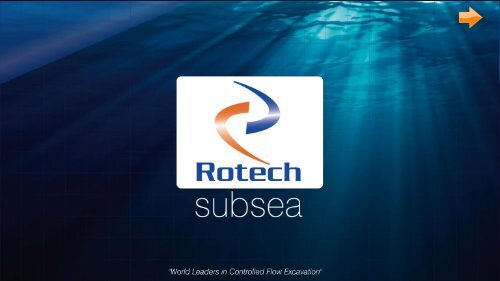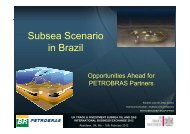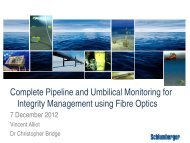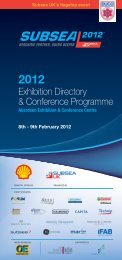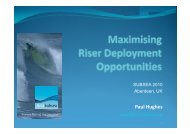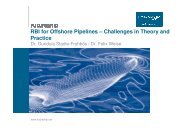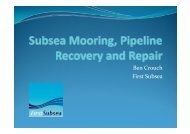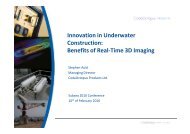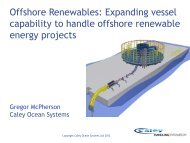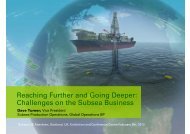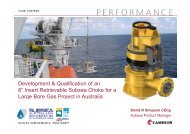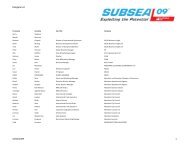Alex Whyte - Rotech Subsea - Subsea UK
Alex Whyte - Rotech Subsea - Subsea UK
Alex Whyte - Rotech Subsea - Subsea UK
You also want an ePaper? Increase the reach of your titles
YUMPU automatically turns print PDFs into web optimized ePapers that Google loves.
Company Overview<br />
HSEQC<br />
Locations<br />
Welcome to <strong>Rotech</strong><br />
Controlled Flow Excavation<br />
Equipment<br />
Applications<br />
Case Studies<br />
Oil & Gas & Renewables<br />
Transport<br />
Clients
Reef <strong>Subsea</strong> Power & Umbilical<br />
-Onshore and Offshore project and<br />
engineering Management<br />
-Installation of submarine cables and<br />
umbilicals<br />
-Trenching<br />
-Remedial and Deburial Services<br />
-<strong>Subsea</strong> Construction<br />
Via Group companies:<br />
ROV and Survey Services<br />
Seabed Dredging.<br />
Reef <strong>Subsea</strong><br />
Established in February 2010<br />
A join venture between:<br />
- GC Reiber Shipping, one of Europe’s premier offshore vessel operators<br />
- HitecVision, leading energy sector private equity investor<br />
Technocean<br />
As part of the Reef <strong>Subsea</strong> Group,<br />
Technocean provides a<br />
comprehensive range of integrated<br />
subsea services in the following key<br />
areas:<br />
IMR services, Light Marine<br />
Construction, <strong>Subsea</strong> Intervention,<br />
Trenching, Cable laying and burial<br />
services, Survey & Positioning<br />
services.<br />
S3<br />
•Offshore installation and construction<br />
support services encompassing route<br />
and site surveys<br />
•IRM services<br />
•Decommissioning services<br />
•Precise positioning and survey services<br />
for construction vessel and drilling rigs<br />
<strong>Rotech</strong> & Scanmudring<br />
Will now be able to offer its clients in<br />
the Oil & Gas and Renewable<br />
industries one of the world’s largest<br />
capabilities in seabed dredging and<br />
excavation services. This will range<br />
from the precise seabed operations<br />
of Scanmudring machines (mainly<br />
Scanmachine and Scancrawler) to<br />
the control/mass flow excavation<br />
capabilities of <strong>Rotech</strong> <strong>Subsea</strong><br />
systems
ISO 18001: 2007<br />
Occupational health and<br />
safety management<br />
HSEQC<br />
<strong>Rotech</strong> <strong>Subsea</strong> have an Integrated management System (I.M.S) certified to:<br />
OHSAS 14001:2004<br />
Environmental management<br />
BS EN ISO 9001:2008<br />
Quality management systems<br />
FPAL Accredited<br />
(reference No. 10050953)
Locations<br />
Houston<br />
Texas<br />
Aberdeen<br />
<strong>UK</strong><br />
Mexico Dubai<br />
Perth<br />
Australia<br />
Singapore
FACT:<br />
<strong>Rotech</strong> <strong>Subsea</strong> are the ONLY company worldwide dedicated to<br />
Controlled Flow Excavation with over 280 projects completed.
High Volume<br />
Low Pressure<br />
Non Contact<br />
Controlled Flow Excavation<br />
(operating on live pipelines &<br />
energised cables)<br />
Excavates all soil types / mud/<br />
sand/ gravel/ rock dump through<br />
to hard clays<br />
Animation of T8000
Equipment<br />
Tools <strong>Subsea</strong><br />
Control<br />
Deployment Video Deck Layout Transport<br />
Deployment Methods
<strong>Subsea</strong> Equipment Tools<br />
All tools are operated using bio-degradable vegetable oil – environmentally friendly<br />
T8000 T4000<br />
R4HP Jetting Systems<br />
Twin R2000
T8000<br />
Height – 6m<br />
Weight – 8 tonnes<br />
Maximum Volume Output – 8,000 litres per sec<br />
Maximum Flow Capacity – 9m per second<br />
Recent Case Study
T4000<br />
Height – 4m<br />
Weight – 5 tonnes<br />
Maximum Volume Output – 4000 litres per sec<br />
Recent Case Study
Twin R2000<br />
Height – 2.6m<br />
Width – 4m<br />
(skid can be adapted for pipes)<br />
Weight – 3.5 mt<br />
Shallow waters<br />
Shore Approach<br />
Recent Case Study
R4HP<br />
Height – 4.5 m<br />
Weight – 6.5 mt<br />
Jetting speed of 8 m/s<br />
Jet Flow rate of 3 m3/s<br />
Jet power of 120hp<br />
2 x T4000 Impellers encased in a single body.<br />
Ideal for access into confined spaces.<br />
Recent Case Study
Jetting Systems<br />
All tools are operated using bio-degradable vegetable oil – environmentally friendly<br />
Augmented Jets<br />
TwinR2<br />
Harder Soils<br />
Twin R2 Central Jets (Video Footage)
Real Time Sonar<br />
Remote Control/Instantaneous Flow<br />
Controlled by Team Leader/Supervisor<br />
<strong>Subsea</strong> Control<br />
<strong>Rotech</strong> Staff – All highly experienced full-time staff<br />
Reason Sonar Seabat 9001 - Full Survey Package<br />
T4000<br />
Trenching 10” pipeline<br />
3.5m depth<br />
Trench width approx 10m at top<br />
NCS Survey<br />
(SVS Monitoring System)<br />
Cable loops on Greater Gabbard<br />
-Shows tools ability to excavate on<br />
curved lay down area
Deployment Methods<br />
Vessel/ Crawler/ A Frame/ Drill String Bow Roller (below)<br />
Deployed from the winch of the cable lay ship to pre-sweep for cable installation at the rear
Deployment Video Footage<br />
T8000 DEPLOYMENT T8000 RECOVERY T4000 CLUMP WEIGHT DEPLOYMENT<br />
Operations/rigging:<br />
Two deck-mounted tuggers fore and aft of the deployment location for sonar orientation<br />
(most effective in depths up to 60 mtrs). 60 mtrs + a clump weight system can be used.
Deck Layout & Spread<br />
Deck Space required – typically 10m x 10m Operates from jack ups, barges, & variety of DP vessels<br />
Generic Image
Operational Depths - Extensions<br />
Cutting Depths Extensions<br />
Deepest depth cut : 21m<br />
“Tetra” in Q4 2009<br />
To keep head above seabed,<br />
extensions are placed on tool<br />
reducing spoil intake<br />
2 x 3m extensions
Operational Depths<br />
Shallow Waters - Super low draft (sld) Deep Water Power Pack<br />
Adapted from the current Twin R2000<br />
Operates in shallow waters from 1.4m<br />
Electro-Hydraulic power pack: 3000m<br />
Spec sheet
Harder Soils<br />
Jetting Ring Augmented Jet Twin R2000<br />
High pressure jet ring breaks soils for CFE<br />
Adapted for T4 & T8<br />
Cutting strength up to 200kPa<br />
T8 power pack drives the two jetting units<br />
while the T4 pump drives the Twin R2000 motors<br />
Cutting Strengths 200kPa+<br />
Operates in shallow waters from 1.6m
De-burial & IRM<br />
Applications<br />
CFE is extremely quick to expose pipe or cable for:<br />
Seabed Preparation<br />
Pipeline lowering/Crossings<br />
Decommissioning/Salvage<br />
Rock Dump<br />
Pre-sweeping & Freespan Correction<br />
Operational Depths & Extensions<br />
Pipeline & Cable Trenching<br />
Additional Services – Harder Soils
Repair<br />
Maintenance<br />
Inspection<br />
Abandonment<br />
Recovery<br />
Tie-ins<br />
No divers needed / Safe non contact<br />
We need a good indication of where the pipe<br />
(for example) is, in some cases, we would<br />
cross trench to find pipe direction<br />
Once identified/located, we give information<br />
to DPO’s to keep on line and we start deburial<br />
De-burial & IRM:<br />
CFE is extremely quick to expose pipe or cable for:<br />
Here <strong>Rotech</strong> worked in 100m water depth.<br />
We removed rock armour in preparation for IRM<br />
work. We re-opened the trench of 3m depth.<br />
Cal-Dive Video<br />
Case Study
- Cleared 2m layers of sand from cap rock<br />
- Removed area (30m x 15m x 2m)<br />
- At 8 locations<br />
Seabed Preparation<br />
East Timor, Jacket Installation<br />
- Allowing jacket legs to be fixed directly to cap rock.<br />
Case Study
Pipeline Lowering & Crossings<br />
CFE Safe Option as Non Contact<br />
Lower the live pipelines & cables in<br />
Alternative to Supports<br />
Less vessel requirement<br />
No diver intervention<br />
Experience gained from projects:<br />
Saudi Arabia – Global Industries<br />
Lowered over 70 pipelines<br />
Original plan was to install supports.<br />
Our lowering rate was 3-5 pipes per day.<br />
Saved client money/time on construction.<br />
Safer with no diver installation.<br />
Pipelines left un-exposed<br />
Case Study
Decommissioning &<br />
Salvage<br />
GOM – Hurricanes<br />
Case Study
Rock Dump Removal<br />
Molikpaq Platform – Sakhalon<br />
Case Study<br />
Typical size and scale of rock dump we can move<br />
Our CFE method is ideal for moving large amounts of rock dump<br />
The client here was installing new pipelines into the platform<br />
Primary method for moving the rock dump was a mechanical grab, concerns were raised regarding damage to existing pipelines<br />
We cleared channels through the rock dump for new pipeline and the grab was not required, we worked from the rock dump vessel<br />
From this project in 2005 we have returned to work here for a number of times for Sakhalin Energy
Pre-Sweeping<br />
& Freespan Corrections<br />
Animations of Freespan Correction<br />
showing before and after footage<br />
Case Study
Firstly trial the area for tool settings/ true kPa<br />
Confirm location with sonar<br />
Pipeline and Cable Trenching<br />
CFE (Non contact) –<br />
Safe method compared to ploughs or sleds<br />
(cause damage with contact)<br />
Power the tool to trench the desired depth<br />
Vessel moves along the pipeline<br />
Transition down to depth specified<br />
Case Study
Oil & Gas<br />
T4 – <strong>Subsea</strong> 7/Centrica<br />
Twin R2 - Visser & Smit<br />
Hanab<br />
Case Studies<br />
<strong>Rotech</strong> <strong>Subsea</strong>…<br />
Latest<br />
Developments<br />
R4HP – Reel Group<br />
/ Invergordon<br />
Renewables<br />
T8 – Red 7 Marine/Fluor<br />
Twin R2 - VSMC
Equipment Transportation
Clients<br />
Want to know more?<br />
<strong>Rotech</strong> <strong>Subsea</strong> Ltd<br />
<strong>Rotech</strong> House<br />
Whitemyres Avenue<br />
Aberdeen<br />
AB16 6HQ<br />
Scotland, <strong>UK</strong><br />
iain.buchan@rotech.co.uk<br />
alex.whyte@rotech.co.uk
T8000<br />
Bahamas<br />
CalDive International Inc - Feb 2011<br />
45 – 90 feet depth<br />
<strong>Rotech</strong>s T8000 mas flow excavation spread was mobilized on board the CalDive pipe lay barge Lonestar.<br />
The work scope was to trench in 10 pipelines offshore the Bahamas.<br />
10 pipelines had been laid in close proximity to each other and the minimum requirement was trenching<br />
them level with seabed. The pipeline details were as follows:<br />
4 x 30” (35” OD)<br />
4 x 24” (28” OD) – one of these had a 4” piggy back line<br />
2 x 14” (16 ½” OD)<br />
Pipeline & Cable Trenching<br />
CalDive International Inc : Bahamas<br />
A total length of approximately 2300 feet of each pipeline was to be trenched.<br />
All 10 pipleines were trenched to specification in 36 1/1 operational hours. An overall progress rate of 3.2m/min<br />
<strong>Rotech</strong>s “NON-CONTACT” method was ideal in this situation, where a sled or plough could not be used.<br />
CalDive Lonestar <strong>Rotech</strong>s T8 Equipment<br />
spread on deck<br />
Sonar image showing T8 trenching<br />
3 pipelines simultaneously<br />
Site Images
T4000<br />
Valhall Field Norway - Q2- 2010<br />
75 meters water depth<br />
Vessel: Geosund 52<br />
De-Burial<br />
<strong>Subsea</strong> 7 Norway/ BP : Valhall Field, Norway<br />
The workscope was to debury designated areas of the 20” concrete coated EKO pipeline to allow access<br />
for a concrete removal manipulator during this re development program.<br />
It was imperative that there was no over excavation creating any freespan.<br />
<strong>Rotech</strong> firstly cut a perpendicular trench across the designated pipeline area to find that was was buried<br />
at 1.1mtr T.O.P Deburial of the pipeline also required additional 1 mtr clearance below the pipeline for the<br />
concrete removal manipulator access and also to allow safe diver access.<br />
We recommended a 3 mtr trench excavated over a length of 25 mtrs would be sufficient<br />
The T4000 prepared the required area for <strong>Subsea</strong> 7 to carry out and complete their re development workscope<br />
for BP within the time frame without incident and to clients satisfaction.<br />
Site Images
T8000<br />
West Delta 117, Gulf of Mexico - Aug–Dec 2010<br />
202 feet water depth<br />
Vessel: Adams Vision<br />
Decommissioning<br />
Anglo Suisse Offshore Partners: West Delta 117,Gulf of<br />
Mexico<br />
A platform was knocked over during a gulf of Mexico hurricane. <strong>Rotech</strong> was contracted to excavate<br />
around 11 bent conductors as part of the decommissioning process.<br />
<strong>Rotech</strong>’s T8000 excavated an area around the conductor bay to give safe diver access to straight pipe<br />
on the conductors, allowing them to be cut and capped.<br />
The platform and 11 conductors were protruding above the mudline. The structure and debris sitting above<br />
the seabed around the conductors were removed before the T8000 spread and personnel were mobilized<br />
on board the vessel. The final excavation was 44 feet deep and at seabed level was 230feet diameter.<br />
Total excavation time for the T8000 was 277 hours.<br />
Total running time for the equipment including deployment, recovery, positioning and survey was 372 hours.<br />
Site Images
T8000<br />
Gulf of Cambay, West Coast of India - March 2007<br />
20 – 40m water depth<br />
A new 20” gas pipeline was being laid as part of the Tapti Field development.<br />
Part of the route had large sand waves, which had to be removed or lowered to prevent the pipeline<br />
from having serious free spans. <strong>Rotech</strong> subsea were contracted to lower the sand waves ain order<br />
to facilitate the new installation.<br />
We had to create a 10m wide lay corridor at the base of the sand waves prior to the installation of the pipeline.<br />
There were 19 sand waves, ranging from 3 to 6m in height, 80 to 280m in length, <strong>Rotech</strong> equipment and crew<br />
were mobilized ion board the REM Fortress. Conditions were challenging, with up to 5 knots and a 5m tidal range.<br />
The sample 3-D image shows the trench that was cut through on particular area.<br />
The lay corridors were cut through the sand waves in a total excavation time of 320 hours,<br />
averaging one sand wave every 17 hours.<br />
Oil & Gas<br />
BG India : Sandwave Pre-sweeping - Gulf of Cambay, West Coast of<br />
India<br />
Site Images
T4000 c/w Jetting Ring<br />
Caspian Sea, Turkmenistan - March-April 2010<br />
60 meters water depth<br />
Clays up to 100kPa Shear Strength<br />
<strong>Rotech</strong> <strong>Subsea</strong> USA LLC was contracted to excavate 3 holes to facilitate the setting of a Jack-Up’s spud cans safely.<br />
A Jack-Up had been in place beside the MDP-A Platform in 2007. A new Jack-Up was to be placed in approximately<br />
the same position, but to do so without stabilising the seabed could be dangerous. The existing holes were around<br />
4 – 5m deep and the possibility was that the rig legs could migrate to these existing holes when jacking up. Petronas<br />
asked <strong>Rotech</strong> <strong>Subsea</strong> Ltd to excavate three holes approximately 28m diameter x 5m deep in the location where the<br />
latest rig would be placed.<br />
Oil & Gas<br />
Jack-Up Installation - Seabed Preparation : Turkmenistan, Caspian<br />
Sea<br />
<strong>Rotech</strong> mobilised a T4000 Mass Flow Excavation tool with auxiliary jetting ring and associated pumping spread onto<br />
the DP vessel Marzhan in Turkmenbashi, Turkmenistan.<br />
Grid patterns were set up on the vessel navigation screen over the required spud can locations and 3 holes with<br />
dimensions 28m x 4.5 to 5.3m depth were completed. Total excavation time for the first (Port Leg) hole was 41 hours.<br />
With the vessel and crew becoming used to the unusual application, the Bow Leg hole was completed in 28 hours with<br />
the Starboard one taking only 22 hours excavation time.<br />
Site Images
R4HP<br />
Invergordon Docks, Inverness - April 2011<br />
10 - 16 meters water depth<br />
Unspecified Mud / Silt<br />
<strong>Rotech</strong> <strong>Subsea</strong> were contracted to clear mud from spud cans off the Galaxy II Jack Up Rig<br />
The tool was positioned inside the leg of the rig and lowered by tuggers to sea level where the<br />
umbilical was fed out form the quayside and attached by Reel rope access personnel.<br />
Divers were deployed to position tool using slings and chains prior to excavation.<br />
In order for the R4HP to clear the angled surface of the can, a chain ratchet block was used<br />
by the divers to pull the bottom of the tool and create a slight angle. The spud can was completely<br />
cleared in 11/2 shifts. The 2nd spud can was also a complete success.<br />
Total excavation time was 20 hours.<br />
Latest Developments<br />
Spud Can Maintenance : Reel Group - Invergordon<br />
Reel Group were very impressed with the capabilities of the tool, its size and manoeuvrability<br />
and the possibility of having different nozzle and/or configuration.<br />
Site Images
T4000<br />
North Sea, <strong>UK</strong> Sector - March 2011<br />
60 meters water depth<br />
1” – 5” Rock Dump<br />
MV Seven Pelican<br />
Oil & Gas<br />
The 122mm Eris umbilical had been damaged and <strong>Rotech</strong> <strong>Subsea</strong> Ltd<br />
was asked to uncover 1200m of it to facilitate and repair. The cable was<br />
covered by 1m of rock-dump in a water depth of 60m.<br />
The T4000 excavation spread was trucked to Peterhead, NE Scotland,<br />
for mobilization on the MV Seven Pelican. Within 7 hours, the kit was<br />
sea fastened on deck and a wet test was conducted just outside the harbour.<br />
A total length of 1268m of cable was fully exposed in 15 hours excavation time,<br />
with deployment and recovery taking around 20 minutes each way.<br />
Referee; Neil Haigh (Centrica Upstream Energy)<br />
SubSea7 / Centrica : Eris Umbilical Deburial & Repair : North<br />
Sea<br />
“the equipment provided performed exactly as had been stated and in fact outperformed what had been expected. I will definitely recommend <strong>Rotech</strong> services”<br />
Site Images
Twin R2000LD<br />
Netherlands - May 2011<br />
3 - 15 meters water depth<br />
Sand and Soft Clay<br />
<strong>Rotech</strong> <strong>Subsea</strong> Ltd were asked to assist in the NorNed cable repair project, offshore Netherlands.<br />
A 300m length of the 217mm x 136mm HVDC cable needed uncovered, to allow the client to lift it on board<br />
the Fetsy-L(top right) and repair it.<br />
The cable was covered in 1m – 1.5m of sand and soft clay, in water depths ranging from approximately 2m to 8m.<br />
<strong>Rotech</strong>s Twin R2000LD Controlled Flow Excavation tool was set up and tested on board the Fetsy-L within 6 hours<br />
of arrival.<br />
The 300m length of cable was uncovered to specification in 1 ½ hours excavation time.<br />
The non-contact method of excavation produced by the TwinR2000LD was ideal for this project, with no chance<br />
of damaging the cable.<br />
Oil & Gas<br />
Visser & Smit Hanab : NorNed Cable Repair - Netherlands<br />
Site Images
T8000 c/w Ancillary Jetting Ring<br />
North Sea, <strong>UK</strong> & Dutch Sectors - Q1- Q2, 2011<br />
50 meters water depth<br />
Renewables<br />
MMT/ABB : Post Trenching of Britned Cables : Southern North Sea<br />
Medium to very hard soils, clay & sand waves<br />
<strong>Rotech</strong> <strong>Rotech</strong> <strong>Subsea</strong> were contracted by MMT to carry out post lay excavation works on the BritNed<br />
interconnector cables, SNS to the required burial depths of 2m<br />
After stringent testing over a section of BritNed cable our T8000 was contracted and deployed from the Olympic Zeuss<br />
to excavate 2 x bundled power cable sections to complete their post lay rectification work. With the size of the workscope<br />
to be completed within given window MMT contracted a second vessel (Stril Explorer) with an identical T8000 spread<br />
to carry out operations from the shallower Dutch sector end of the BritNed work scope to meet with the Zeus coming in<br />
from the <strong>UK</strong> end of the cable. Soils varied from soft sand to over 100kpa sheer strength.<br />
The jetting ring was only active when we encountered heavy clay to assist with breaking through the surface.<br />
52km of BritNed cable was successfully lowered to the required protection depths of 2m. The workscope was<br />
carried out to specification without incident, safely and the integrity of the Britned cable was never endangered.<br />
Site Images
T8000<br />
Oil & Gas<br />
Pipeline Crossings Persian Gulf<br />
Live Pipeline & Cable Lowering for New Pipeline Installation<br />
Global Industries Ltd for Saudi Aramco/Kuwaiti Oil JV<br />
Saudi Arabia - September 2007 - Duration: 3 weeks<br />
Up to 35 meters water depth<br />
A new pipeline was being laid in the Persian Gulf as part of the Khafji Field Development. <strong>Rotech</strong> <strong>Subsea</strong> were contracted<br />
to lower existing pipelines and cables in order to facilitate the new installation.<br />
Scope of Work<br />
The existing infrastructure comprised of 59 no. 4” cables and pipelines of various sizes up to 10” diameter. <strong>Rotech</strong> were<br />
required to transition these down to 1m cover at the crossing point. The Client would then sandbag these crossing points<br />
and install the new pipeline.<br />
The <strong>Rotech</strong> equipment and crew were mobilized on board the vessel REM Fortress in Sharjah, UAE. The equipment was set up and tested prior to sailing to<br />
Saudi Arabia. Due to the non-contact method of excavation employed by the <strong>Rotech</strong> tools, the trenching of the live pipelines was completed with no risk to the<br />
pipeline integrity. The instant controllability of the T8000 allowed our Supervisors to create transitions down to the specified depth and back out.<br />
The 59 crossings were lowered to specification in 65 operational hours. Total time on board was approximately 3 weeks.<br />
<strong>Rotech</strong> saved the Client significant cost and time compared to alternatives such as installing supports on the seabed for the new pipeline.<br />
Referee - Michael Empey : Global Industries Ltd.
Renewables<br />
Red 7/ Fluor : Post Trenching of Power Cables & J Tube Entry<br />
T8000 c/w Ancillary Jetting Ring<br />
around Monopiles, Greater Gabbard<br />
Greater Gabbard Field, Southern North Sea - Q2 – Q4 2010<br />
10 – 30 meters water depth<br />
Medium to very hard soils & clay<br />
<strong>Rotech</strong> <strong>Subsea</strong> was contracted by Red 7 to carry out post lay excavation work of power cables<br />
in Greater Gabbard Field, Southern North Sea<br />
T8000 deployed from Bourbon Enterprise to excavate cable sections and cable loops to complete post lay<br />
rectification work along with J Tube entry around base of monopiles.<br />
Some soils in excess of 100 kPa sheer strength so we included our ancillary ring which allowed us to excavate in<br />
excess of 200 kPa. Once the rings had cut through the heavy clay surface the T8 completed the task on its own.<br />
The power and controllability of this tool along with out full time professional and competent team ensured a safe<br />
and successful outcome.<br />
The clients criteria and specifications were met without incident and the cables integrity was never in question.<br />
The post lay rectification work was carried out safely and successfully to allow Red 7 to complete their required<br />
work scopes for their client<br />
Site Images
Renewables<br />
VSMC / BV : Walney Wind Farm Cable Trenching : Irish Sea<br />
Twin R200 c/w Auxillary Jets<br />
Walney Wind Farm, Irish Sea - December 2010<br />
4 - 12 meters water depth<br />
Dense Sand conditions<br />
<strong>Rotech</strong> <strong>Subsea</strong> were contracted to trench 900, of an 8” cable to a minimum 3m below seabed level. An alternative<br />
method of trenching had previously been used, but damaged the cable. <strong>Rotech</strong>’s NON-CONTACT Controlled flow<br />
Excavation system was therefore ideal for this application.<br />
Prior to commencing the Client requested a trial to show what effect the high pressure jets from the winR200<br />
would have on the nylon cover of the cable. This was carried out on the deck, as the two photos on the right<br />
show the trial in progress and the minimal erosion of the cable cover respectively. The client stated that they<br />
would have expected more damage to occur during the lay process and was more than satisfied with the results.<br />
The 900m length of cable was trenched to a depth greater than 3m below seabed in only 36 hours.<br />
<strong>Rotech</strong> were then requested a trial trench be excavated in an area where a plough had previously failed to get to<br />
the required depth. Again the Twin R2000 proved its worth, achieving a trench of 1m depth in a single pass.<br />
A sample of the clay was taken and analysed by a Torvane Tester, the shear strength of the sample being 70kPa.<br />
Site Images
Twin R2000 : Harder Soils<br />
*Twin R2000 with props directed towards<br />
each other at a 22 degree angle with high<br />
pressure jets to cut through harder soils<br />
*This joined the flows form the 2 props<br />
directly over the cable to reach the trench<br />
depth but also limit the width of the trench<br />
*Trench 2 m wide and 1.74m deep<br />
The hard rocks were removed using the<br />
control flow of the Twin R2 excavator and<br />
the clay area was cut up using the jets.<br />
Then the CF removed them from the<br />
trenching area.<br />
CF alone would not have managed to dig<br />
into the clay areas.<br />
Some materials that were recovered<br />
during final part of the excavation
T4 Spread<br />
KEY<br />
3<br />
4<br />
Deck Layout & Spread<br />
1<br />
1 – Hose Reel – 2.1m x 2.1 x 2.2 x 5.6Te<br />
2 – HPU – 3.9m x 1.9 x 2.0 x 4.8Te<br />
3 – Spares Container - 6.1m x 2.4 x 2.6 x 8Te<br />
4 – T4000 – 3.8m x 1.9 x 2.5 x 5.5Te<br />
5 – Overboard Chute for Hoses<br />
5<br />
2<br />
T8 Spread<br />
KEY<br />
4<br />
3<br />
1<br />
2<br />
1 – Hose Reel – 3.0m x 3.0 x 3.0 x 12.5Te<br />
2 – HPU – 6.1m x 2.4 x 2.6 x 14.5Te<br />
3 – Spares Container - 6.1m x 2.4 x 2.6 x 8Te<br />
4 – T8000 – 5.9m x 2.1 x 3.2 x 8Te<br />
5 – Overboard Chute for Hoses<br />
5
Underwater Power Pack (UPP)<br />
The <strong>Rotech</strong> Underwater Power Pack (UPP) replaces the usual topside<br />
diesel-powered hydraulic pump with an electrically driven hydraulic pump<br />
sited with the tool, to permit operation in much deeper water than is<br />
possible with the standard arrangement.<br />
The system is designed to operate to a depth of around 3,000m,<br />
depending on the handling system and umbilical.<br />
APPLICATIONS<br />
♦ Pipeline/Cable Trenching<br />
♦ Decommissioning & Abandonment Excavation<br />
♦ Free Span Rectification<br />
♦ Inspection, Repair & Maintenance Excavation<br />
♦ Pre-Sweeping/Seabed Preparation


